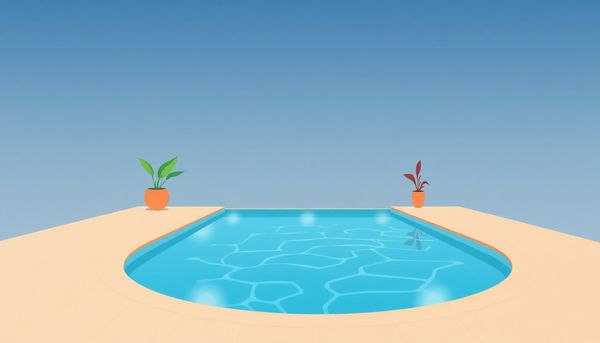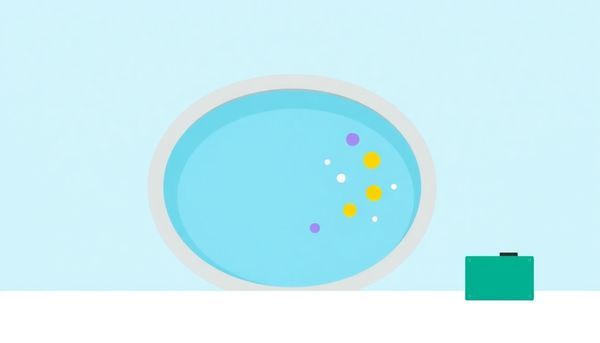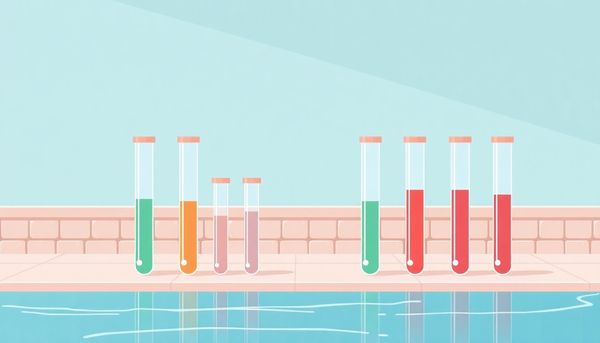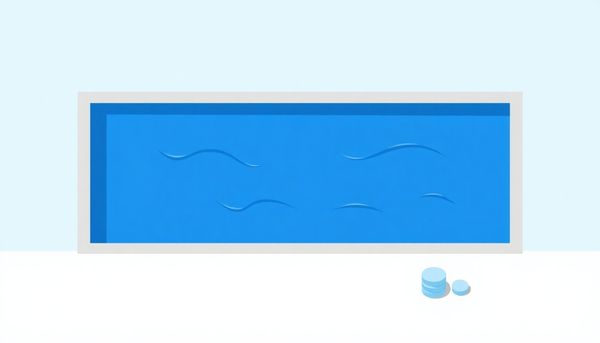Free vs. Combined Chlorine: Key Insights for Pool Owners
July 12th, 2024
July 12th, 2024
Chlorine—a name so familiar to anyone who has ever swum in a pool or used bleach in household cleaning. Yet, few pause to consider the nuances that lie beneath its surface uses. An afternoon spent at a local swimming pool could reveal a curious chemical landscape, where free chlorine dances and total chlorine lingers. Understanding the distinction between these two forms is not just for the chemists in labs, but also for anyone invested in maintaining safe and clean water environments.
When I first delved into the world of pool maintenance, I quickly learned that chlorine is not a singular entity. Encountering terms like "free" and "total" chlorine was akin to unraveling a mystery. Free chlorine refers to the amount of chlorine available to sanitize and kill harmful microorganisms. It's the active player, ready to tackle bacteria and viruses as they emerge. On the other hand, total chlorine includes all the chlorine present in the water, both the active free chlorine and the combined chlorine—chlorine that has already reacted with contaminants.
Knowing this difference can be the key to effective water treatment. Balancing free and total chlorine levels ensures safety without an overpowering chemical odor—a common complaint from pool-goers. Whether managing a community pool or simply ensuring clean drinking water at home, grasping these chlorine concepts is invaluable. Just as a chef must understand their ingredients, so too should anyone responsible for water quality appreciate the chemistry at play.

Grasping the essentials of free chlorine is crucial for any pool owner aiming for crystal-clear waters. I remember the first summer with my own pool; I naively thought that dumping any form of chlorine would suffice. Little did I know that free chlorine is the hero in this aquatic tale. Unlike its combined counterpart, free chlorine is unbound and actively seeks out harmful bacteria and contaminants, ensuring an impeccably sanitized swimming environment.
In practical terms, free chlorine is the active agent doing the heavy lifting. When measured correctly, it should hover between 1 and 3 parts per million (ppm), with 3 ppm being the sweet spot for optimal sanitation. It's a bit like seasoning a dish; too little and you barely notice the effect, too much and it overwhelms. Ensuring the right balance keeps your pool inviting and safe.
Consider that free chlorine acts as a vigilant guardian, constantly on guard against impurities. This vigilance comes at a cost; as it combines with pollutants, its effectiveness wanes, transforming into combined chlorine. Regular testing, using reliable test strips or liquid kits, can prevent this transformation from compromising your pool’s health. A routine check ensures that free chlorine levels remain higher than combined chlorine levels, maintaining your pool’s sparkling integrity.
In the world of pool maintenance, chlorine takes on different roles, each crucial for keeping your pool safe and sparkling. Free chlorine is the linchpin of pool sanitation. Think of it as the active guardian, waiting to combat the bacteria and algae that dare enter the water. Without free chlorine, the pool would quickly become a breeding ground for unwanted guests. It’s like having a security team on standby, ready to address potential threats before they cause harm.
On the other hand, combined chlorine is what forms after free chlorine has done its job. Once free chlorine neutralizes contaminants, it bonds with them, becoming combined chlorine. Imagine a used-up sponge—it has absorbed the grime but can't clean anymore. This type of chlorine, often referred to as chloramines, not only loses its sanitizing power but also brings the unwelcome smell of a heavily chlorinated pool, irritating to swimmers’ eyes and skin.
Understanding these differences is more than academic; it’s practical wisdom for every pool owner. Regular testing is vital. When I first learned to balance my pool, I used to wonder why my eyes stung despite using what seemed like enough chlorine. Testing revealed high levels of combined chlorine. Swift action to adjust levels transformed the swimming experience. So, by keeping free chlorine levels higher than combined, your pool remains an oasis of health and clarity.
Balancing chlorine levels in your pool is a bit like maintaining the perfect recipe for a favorite dish. It requires the right measurements and a keen eye for detail. The essence of keeping your pool sparkling lies in knowing the precise balance between free and combined chlorine. Regular testing isn’t just for peace of mind; it’s an essential part of pool ownership.
Those test strips or liquid kits aren't just gadgets—they're your pool's best friends. Regular checks, ideally once a week, help you stay ahead of any potential issues. Think of it as a health check-up for your pool. A quick test can immediately tell you if the free chlorine is doing its job of keeping the water safe and sanitized. If levels are low, it’s time to add more chlorine to boost the free chlorine concentration back to that sweet spot around 3 ppm.
But what if the combined chlorine is creeping up? It’s a red flag indicating that the chlorine is working overtime, battling impurities and forming chloramines. A simple yet effective solution involves a process called “shocking” the pool. By adding a large dose of chlorine, you break down the chloramines, replenishing the free chlorine levels. It's like giving your pool a refreshing reset.
With regular monitoring and adjustments, you'll keep your pool inviting and safe. After all, a well-balanced pool isn’t just clean water—it’s the foundation for endless summer fun.
Ensuring that your pool’s free chlorine levels remain optimal is akin to mastering a delicate balancing act. One summer, my friend decided to host a pool party without checking her chlorine levels, believing that a single dose at the start of the season was enough. An hour into the party, a whiff of chloramine-laden air—the infamous “pool smell”—made it clear something was amiss. This odor, often mistaken for chlorine, is a telltale sign of insufficient free chlorine and the presence of combined chlorine.
Free chlorine acts as your pool’s primary defense against harmful bacteria and contaminants. Ideally, you should aim for a concentration between 1 and 3 parts per million (ppm) to ensure effective sanitization. Testing your water at least twice a week during peak swimming season is crucial. This isn’t just about keeping algae at bay; it’s about safeguarding your loved ones from skin irritations and eye discomfort caused by high combined chlorine levels.
To maintain these levels, consider using a stabilizer like cyanuric acid, which protects chlorine from being rapidly degraded by sunlight. It’s also wise to shock your pool regularly, especially after heavy use or rainstorms, to reset the free chlorine levels. By understanding and actively managing these levels, you can turn your pool into a haven of health and happiness, rather than a breeding ground for unwanted surprises.

Balancing total chlorine levels in your pool is akin to becoming a poolside alchemist, where the right mix keeps everything sparkling and safe. Total chlorine, the sum of free and combined chlorine, acts as the ultimate measure of your pool’s health. However, managing this requires more than simply pouring chemicals and hoping for the best.
One summer, I found myself puzzled by a persistent chlorine odor despite regular maintenance. After a quick test, it turned out that my total chlorine levels were off, signaling an increase in combined chlorine. To tackle this, regular testing became my trusty compass. A simple test strip can reveal the story of your pool's chemistry, showing if the free chlorine is doing its job or if combined chlorine is taking over.
When the total chlorine level surpasses the free chlorine level, it's a sign that combined chlorine, or chloramines, is present. The solution often involves a process called "shocking" the pool. This entails adding a large dose of chlorine to break down the chloramines and restore balance. It’s like hitting the reset button for your pool, ensuring that free chlorine is once again dominant and ready to sanitize effectively.
Consistent management of total chlorine levels not only safeguards the pool's clarity but also the health of its swimmers. With regular checks and timely interventions, you can ensure your pool remains a haven of fun rather than a breeding ground for bacteria.
Chlorine may seem like a straightforward pool companion, but it's a bit of a shape-shifter in the aquatic realm. When you first introduce chlorine into your pool, what you’re really adding is a powerful cleaning agent called free chlorine. This is the stuff that’s geared up and ready to tackle bacteria and other unwelcome guests swimming in your pool. It's the lifeguard on duty, keeping things in check.
But not all chlorine remains free. As it gets to work, free chlorine combines with pollutants, transforming into combined chlorine. This new form still floats in your pool, but it’s no longer the vigilant guardian you need. Instead, combined chlorine can sometimes be a nuisance, contributing to that familiar “chlorine smell” and causing irritation to swimmers' eyes and skin.
Enter total chlorine, the sum of both free and combined chlorines in your pool. Keeping tabs on this value is crucial. If your pool's total chlorine mirrors its free chlorine, you’re in the clear, as no chlorine has been compromised. However, if total chlorine surpasses free chlorine, you’ve got some combined chlorine lurking about.
Maintaining a healthy pool means ensuring free chlorine stays on top. Regular testing with strips or kits ensures this delicate balance, allowing you and your family to splash around without a care in the world.
Testing chlorine levels regularly is like giving your pool a health checkup. It ensures that the water is safe and inviting for everyone. I remember the first time I tested my pool's chlorine levels; I was surprised at how straightforward the process was and how much it revealed about my pool's health. A quick dip of a test strip or a few drops from a liquid kit can unveil whether your pool is a sparkling oasis or a breeding ground for bacteria.
Each time you test, you're measuring both the free and total chlorine. These readings tell a story about the water's current condition. Free chlorine is your pool's active sanitizer, ready to tackle impurities head-on. Meanwhile, total chlorine reflects the sum of free and used-up chlorine, indicating how much of your pool's sanitizing power has been spent. If total chlorine outweighs free chlorine, it suggests that combined chlorine, or chloramines, is present, which can cause eye irritation and unpleasant odors.
Regular testing, perhaps weekly or more during heavy use periods, allows you to adjust chlorine levels before problems emerge. It's like catching a cold early before it turns into a full-blown flu. By understanding these numbers, you’re not just maintaining a pool; you're ensuring a safe and enjoyable environment for your family and friends.
Ensuring your pool's free chlorine level remains optimal is akin to finding the sweet spot in a recipe—too little, and the dish falls flat; too much, and it overwhelms the senses. Achieving the ideal range of 1 to 3 ppm is crucial for both effective sanitation and swimmer comfort. It's like having the perfect balance in your favorite lemonade—refreshing and just right.
Start with regular testing. Much like checking the freshness of ingredients before cooking, testing your pool water frequently gives you an accurate picture of the free chlorine levels. Test strips or a liquid test kit are reliable tools. Keeping a log of these results can help you spot trends and make informed adjustments.
Approach adjustments strategically. If your free chlorine is too low, consider using stabilized chlorine pucks, which dissolve slowly and maintain levels without sudden spikes—similar to how a slow cooker gradually infuses flavors. On the other hand, if levels are too high, simply let the sun work its magic. Ultraviolet rays naturally dissipate excess chlorine over time, much like airing out a room filled with too much fragrance.
Finally, maintain your pool's pH levels between 7.2 and 7.8. This helps chlorine work more efficiently, akin to adjusting the oven temperature to ensure even baking. By keeping these elements in harmony, you ensure your pool remains a sparkling oasis, ready for endless summer joy.

Pools sparkle under the sun, promising refreshing dips, but maintaining that inviting clarity requires understanding the chemistry. Chlorine, the unsung hero, comes in different forms, each playing a distinct role. When diving into the world of chlorine, you'll first encounter free chlorine. This is your pool's frontline defense, actively sanitizing and oxidizing unwanted contaminants. Think of it as the vigilant guard, always on duty to ensure the water is safe for swimmers.
The plot thickens with combined chlorine, which forms when free chlorine reacts with organic matter such as sweat, oils, or other nitrogenous compounds. It’s like a firefighter who’s exhausted from battling blazes and can't fight any new fires effectively. Combined chlorine leads to the production of chloramines, often responsible for that familiar "chlorine smell" and eye irritation. Despite its presence, it doesn't contribute to sanitization, marking it as a spent force in the fight for cleanliness.
Finally, total chlorine is the sum of both free and combined chlorine. It's the overall measurement that helps pool owners gauge the level of active sanitization versus used-up chlorine. Keeping an eagle eye on these levels ensures that free chlorine maintains its superiority over combined chlorine, preventing odors and maximizing sanitization. Understanding these distinctions is not just chemistry; it's the key to a poolside haven where enjoyment and safety go hand in hand.
Free chlorine is the unsung hero of pool maintenance, quietly working its magic to ensure every swim is safe and refreshing. Unlike its counterparts, free chlorine is fully available and ready to tackle unwelcome guests in your pool—bacteria, algae, and other harmful pathogens. Think of it as your pool's first line of defense, always on alert to maintain crystal-clear water.
Dissolving chlorine in water sets off a chemical reaction, forming hypochlorous acid and hypochlorite ions. These compounds, collectively known as free chlorine, actively sanitize by oxidizing contaminants. This process is akin to a vigilant lifeguard patrolling the pool, ensuring every dive or splash remains enjoyable and risk-free. For effective sanitization, maintaining free chlorine levels between 1 and 3 parts per million (ppm) is crucial, with 3 ppm being the sweet spot for optimum safety.
During one summer, I learned the hard way what happens when free chlorine dips too low. A sudden onslaught of algae had turned our pool green seemingly overnight. Realizing the oversight, we swiftly tested and adjusted the chlorine levels, witnessing firsthand how essential free chlorine is in reclaiming our backyard oasis.
By regularly testing and adjusting free chlorine levels, you prevent the onset of combined chlorine, which forms when free chlorine bonds with pollutants. This proactive approach keeps your pool not just usable, but a vibrant part of your summer fun. Properly balancing free chlorine levels ensures that both you and your pool guests can confidently enjoy those sunny swim sessions.
Understanding combined chlorine might seem daunting at first, but let’s peel back the layers. Picture a bustling pool party: free chlorine is the diligent lifeguard, ever-ready to tackle any unruly guests, like bacteria or algae, that try to crash the party. But when these guests show up, they engage in a scuffle with the lifeguard, and what results is combined chlorine—a sort of worn-out lifeguard, still present but far less effective.
The creation of combined chlorine occurs when free chlorine reacts with contaminants such as sweat, urine, or other organic materials commonly introduced by swimmers. During this interaction, combined chlorine—often in the form of chloramines—is produced. Imagine the chloramines as tired lifeguards who've already spent their energy dealing with troublemakers. This type of chlorine lurks in the water, creating that familiar, irritating chlorine smell often mistaken as a sign of cleanliness. Ironically, a strong chlorine scent hints at the need for more free chlorine, not less.
To keep your pool sparkling and safe, regularly testing and ensuring the free chlorine levels remain higher than combined chlorine is essential. The goal is to let your lifeguard team work efficiently, maintaining order and hygiene without becoming overwhelmed. A balanced pool is a happy pool, where the water is as inviting as a cool breeze on a hot summer day.
Understanding chlorine levels is like maintaining the balance in a recipe—too much or too little of an ingredient can alter the entire dish. Monitoring total chlorine levels in your pool is akin to ensuring that your culinary masterpiece turns out just right. Each time you test your pool, you're actually getting a snapshot of the chlorine story in your water: the tale of both free and combined chlorine.
When I first started maintaining my own pool, I underestimated the importance of regular testing. I figured as long as I'd tossed in a few chlorine tablets, I was good to go. It wasn't until I noticed a persistent, unpleasant smell and eye irritation among my guests that I dived deeper into the chemistry. That was my wake-up call: understanding that the total chlorine level is the sum of free chlorine, which is ready to fight off germs, and combined chlorine, which has already done its job and now needs to be dealt with.
Testing regularly with a reliable kit helps catch any imbalance early. Think of it as a routine check-up for your pool's health. If total chlorine outpaces free chlorine, it’s time for a shock treatment to reset the balance. Remember, a proactive approach ensures your pool remains a safe and pleasant oasis, free from lurking contaminants. Keep those chlorine levels in check, and your pool will reflect your care and vigilance.

Imagine the thrill of a perfect cannonball splashing into crystal-clear pool water—nothing beats it. Yet, beneath that inviting surface, the chemistry of chlorine works tirelessly to keep everything safe and sparkling. Regularly testing your pool’s chlorine levels isn’t just a chore; it’s a vital part of ensuring a healthy swimming environment.
Every week, as you lean over the pool edge with a test strip in hand, you’re embarking on a small but crucial mission. Think of it as a routine check-up, much like visiting the doctor. Free chlorine, the hero in this aquatic saga, needs to be consistently measured. This ensures it’s at the ideal level, typically between 1 and 3 parts per million. Aim for that sweet spot to effectively fight against contaminants without overdoing it.
Your diligence doesn’t end there. Pay attention to total chlorine, which includes both free and combined chlorine. If the two levels align, all’s well. However, if total chlorine surpasses free chlorine, there’s a build-up of combined chlorine—an indicator that some of your chlorine is tangled up with unwanted contaminants. This necessitates a bit of troubleshooting, perhaps a shock treatment to clear things up.
Remember, keeping those chlorine levels in check isn’t just about numbers. It’s about maintaining a safe, fun space for everyone to enjoy those sunny days without a care in the world. So, keep those test kits handy and let the splashes begin!
Chlorine plays a crucial role in maintaining the cleanliness and safety of your pool, but understanding its different forms is essential. Grasping the distinction between total, free, and combined chlorine can help ensure your pool remains a safe haven for swimmers.
Let’s talk about free chlorine first. This is the hard-working agent actively sanitizing your pool, ready to tackle contaminants like bacteria and algae. When you test your pool water, free chlorine is what you’re primarily interested in, aiming for that sweet spot of 1 to 3 parts per million (ppm). This range ensures effective sanitization without creating harsh swimming conditions.
On the other hand, combined chlorine represents the aftermath of free chlorine doing its job. Once free chlorine reacts with impurities in the water, it transforms into combined chlorine, often resulting in unpleasant odors and eye irritation. High levels indicate the pool isn't as effective at sanitizing as it should be, signaling a need for action to restore balance.
Total chlorine is essentially the sum of these two types. By keeping a close watch on these levels, you can deduce your pool’s health. If total chlorine matches free chlorine, your pool is in tip-top shape. But if total chlorine exceeds free chlorine, it's time to address the lurking combined chlorine.
To maintain a sparkling sanctuary, regular water testing is vital. Whether using test strips or a liquid kit, understanding your chlorine levels is the key to a safe and enjoyable swimming experience.
Testing free-chlorine levels in your pool is a task that might seem trivial, but it plays a crucial role in ensuring your swimming sanctuary is both safe and inviting. The process begins with understanding what free chlorine is: it's the active form of chlorine that sanitizes your pool, battling bacteria and other unwanted guests.
To effectively test free-chlorine levels, you can use either test strips or a liquid test kit. Personally, I've found test strips to be user-friendly and quick, especially during those busy summer days when all you want is a refreshing dip without the hassle. Simply dip a strip into the water, wait a few seconds, and compare the color change to the chart provided. The goal is to maintain levels between 1 and 3 ppm, with 3 ppm being the sweet spot for optimal cleanliness.
On the other hand, liquid test kits offer more precision, akin to being in a mini-laboratory. This method might require a bit more patience, as you'll need to add specific reagents to a water sample and observe the color shift. But the accuracy can be worth the extra effort, especially if you’re dealing with heavy pool use or fluctuating weather conditions impacting your water chemistry.
Regular checks are essential. Monitoring these levels helps prevent the buildup of combined chlorine, ensuring that your pool remains a pristine oasis. Remember, consistent testing is the key to a safe swimming environment, keeping the fun in the water and worries at bay.
Maintaining the right chlorine balance in your pool is a bit like tending a garden; it's all about attention and timing. The goal is to ensure that free chlorine—your main sanitizing agent—stays effective by reacting only with potential contaminants, not by simply diluting into oblivion. This balance is crucial, as too much combined chlorine can lead to unpleasant odors and irritation, much like a garden overrun with weeds.
When I first started managing my own pool, I assumed that dumping in chlorine tablets was sufficient. However, I quickly learned that the secret lies in regular testing and adjusting. Every few days, I'd grab my test strips, dip them into the water, and see where my levels stood. Sometimes, I'd find that the free chlorine levels had dipped, signaling that it was time to add more chlorine to prevent the combined chlorine from taking over.
A bit of vigilance goes a long way. Checking levels frequently allows you to catch issues before they escalate. If you find that your combined chlorine level is creeping up, a good shock treatment can reset your pool’s balance. Think of it as resetting a stubborn electronic device—a swift, decisive action to restore functionality.
Remember, balancing chlorine isn't just about pouring chemicals into the water. It's an ongoing process of monitoring, understanding reactions, and making informed adjustments. With practice, you'll gain the confidence to keep your pool a safe and refreshing haven.

Achieving optimal pool sanitation is akin to mastering a delicate dance of chemistry and maintenance. The goal is not just to toss in any chlorine and hope for the best. Instead, understanding the role of free chlorine and its counterparts is vital. Picture a summer afternoon where you joyfully splash around, oblivious to the chemistry silently at work ensuring your safety. However, without proper balance, an unsanitized pool can quickly become a breeding ground for bacteria and algae.
Start by routinely testing your pool water. Using reliable test kits, measure the levels of total, free, and combined chlorine. These readings provide a snapshot of your pool's health. If the free chlorine level is insufficient compared to the combined chlorine, consider adding more chlorine to restore balance. Aim for a free chlorine level of around 3 ppm for optimal sanitation.
Shock treatments occasionally become the unsung heroes of pool maintenance. By elevating the chlorine levels temporarily, they effectively oxidize the accumulated contaminants, converting combined chlorine back into free chlorine. This process not only clears cloudy water but revitalizes the sanitizing capability of the chlorine present.
Remember the importance of timing. Test and adjust chlorine levels during periods of heavy pool usage or after a rainstorm, as both can impact water quality. Through diligent practice, your pool remains a safe haven for laughter and play, with peace of mind woven into every splash.
Understanding chlorine types is akin to knowing the characters in a play; each has a distinct role that contributes to the overall performance. In the watery world of pools, chlorine takes on three major personas: free, combined, and total chlorine. Each type plays a unique part in keeping waters clean and safe for a summer splash.
Free chlorine is the hero of our tale. It's the active agent, ready to tackle bacteria and other contaminants. Think of it as the lifeguard, vigilantly patrolling and ensuring safety. Its effectiveness is crucial, which is why testing for free chlorine levels is a non-negotiable task for pool owners.
Next, we meet combined chlorine, the side effect of free chlorine doing its job. Once free chlorine interacts with pollutants, it transforms into combined chlorine, a less potent version. In essence, it’s the chlorine that’s already been "used up" in the battle against impurities. You might notice its presence by a familiar chlorine smell, often mistaken as a sign of cleanliness, when in reality, it's a cue for action.
Finally, total chlorine is the sum of these two characters: free plus combined. It offers a complete picture of the chlorine landscape in your pool. Armed with this knowledge, you can ensure the free chlorine remains higher than the combined chlorine, maintaining the delicate balance required for a pristine swimming experience. Remember, understanding these roles not only keeps your pool pristine but also safeguards those cherished summer memories.
Under the blazing sun, as you prepare for a refreshing dip in your pool, the last thing you want is a murky surprise awaiting. Regular testing of your pool water is a crucial ritual, akin to checking the oil in your car before a long drive. It's not just about peace of mind; it's about maintaining a sanctuary of health and safety. Each test, whether with strips or a liquid kit, reveals the delicate balance between total and free chlorine, offering insights into the unseen chemistry at play.
Consider the scenario when pool water becomes a science experiment gone awry. One summer, a friend of mine neglected this important step, trusting the shimmering surface to tell the whole story. The result? Red eyes, irritated skin, and a sudden influx of complaints from swimmers. It turned out the combined chlorine was secretly feasting on the sanitizing power of the free chlorine, leaving the water less safe than it appeared.
To prevent such mishaps, make pool testing a routine. Frequent checks ensure that free chlorine levels remain optimal, outpacing the combined chlorine that diminishes sanitation power. By keeping a watchful eye, you not only maintain a pristine pool but also protect those who swim in it. With each test, you’re investing in a summer of carefree splashes and laughter, confident in the water's clarity and safety.

This article provided insights into maintaining your pool. Start your pool care journey today!
Want to become a pool maintenance expert? Our free Pool School course covers everything you need to know about pool care. From basic maintenance to advanced troubleshooting, you'll learn how to:
Join over 10,000 pool owners who have already transformed their pool care routine. Get started with our free Pool School course today!